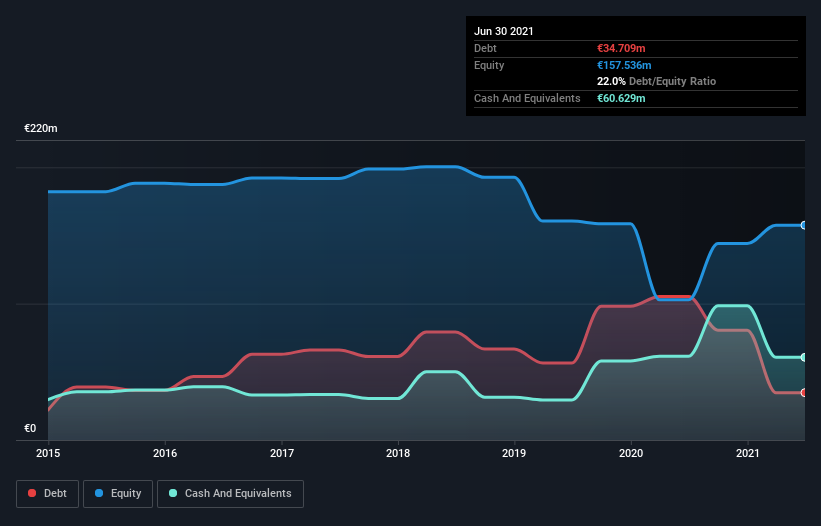
David Iben put it well when he said, 'Volatility is not a risk we care about. What we care about is avoiding the permanent loss of capital.' When we think about how risky a company is, we always like to look at its use of debt, since debt overload can lead to ruin. We can see that Damartex (EPA:ALDAR) does use debt in its business. But is this debt a concern to shareholders?
Why Does Debt Bring Risk?
Debt and other liabilities become risky for a business when it cannot easily fulfill those obligations, either with free cash flow or by raising capital at an attractive price. If things get really bad, the lenders can take control of the business. However, a more usual (but still expensive) situation is where a company must dilute shareholders at a cheap share price simply to get debt under control. By replacing dilution, though, debt can be an extremely good tool for businesses that need capital to invest in growth at high rates of return. When we think about a company's use of debt, we first look at cash and debt together.
See our latest analysis for Damartex
What Is Damartex's Debt?
You can click the graphic below for the historical numbers, but it shows that Damartex had €34.7m of debt in June 2021, down from €105.3m, one year before. However, its balance sheet shows it holds €60.6m in cash, so it actually has €25.9m net cash.

A Look At Damartex's Liabilities
According to the last reported balance sheet, Damartex had liabilities of €237.1m due within 12 months, and liabilities of €102.4m due beyond 12 months. On the other hand, it had cash of €60.6m and €45.6m worth of receivables due within a year. So its liabilities total €233.3m more than the combination of its cash and short-term receivables.
This deficit is considerable relative to its market capitalization of €243.4m, so it does suggest shareholders should keep an eye on Damartex's use of debt. This suggests shareholders would be heavily diluted if the company needed to shore up its balance sheet in a hurry. Despite its noteworthy liabilities, Damartex boasts net cash, so it's fair to say it does not have a heavy debt load!
It was also good to see that despite losing money on the EBIT line last year, Damartex turned things around in the last 12 months, delivering and EBIT of €19m. There's no doubt that we learn most about debt from the balance sheet. But ultimately the future profitability of the business will decide if Damartex can strengthen its balance sheet over time. So if you're focused on the future you can check out this free report showing analyst profit forecasts.
Finally, a business needs free cash flow to pay off debt; accounting profits just don't cut it. Damartex may have net cash on the balance sheet, but it is still interesting to look at how well the business converts its earnings before interest and tax (EBIT) to free cash flow, because that will influence both its need for, and its capacity to manage debt. Over the last year, Damartex actually produced more free cash flow than EBIT. There's nothing better than incoming cash when it comes to staying in your lenders' good graces.
Summing up
While Damartex does have more liabilities than liquid assets, it also has net cash of €25.9m. And it impressed us with free cash flow of €53m, being 273% of its EBIT. So we are not troubled with Damartex's debt use. The balance sheet is clearly the area to focus on when you are analysing debt. However, not all investment risk resides within the balance sheet - far from it. For example - Damartex has 1 warning sign we think you should be aware of.
When all is said and done, sometimes its easier to focus on companies that don't even need debt. Readers can access a list of growth stocks with zero net debt 100% free, right now.
New: Manage All Your Stock Portfolios in One Place
We've created the ultimate portfolio companion for stock investors, and it's free.
• Connect an unlimited number of Portfolios and see your total in one currency
• Be alerted to new Warning Signs or Risks via email or mobile
• Track the Fair Value of your stocks
Have feedback on this article? Concerned about the content? Get in touch with us directly. Alternatively, email editorial-team (at) simplywallst.com.
This article by Simply Wall St is general in nature. We provide commentary based on historical data and analyst forecasts only using an unbiased methodology and our articles are not intended to be financial advice. It does not constitute a recommendation to buy or sell any stock, and does not take account of your objectives, or your financial situation. We aim to bring you long-term focused analysis driven by fundamental data. Note that our analysis may not factor in the latest price-sensitive company announcements or qualitative material. Simply Wall St has no position in any stocks mentioned.
About ENXTPA:ALDAR
Damartex
Offers clothing and accessories for seniors primarily in France, the Great-Britain, Belgium, and Germany.
Undervalued with moderate growth potential.
Market Insights
Community Narratives



